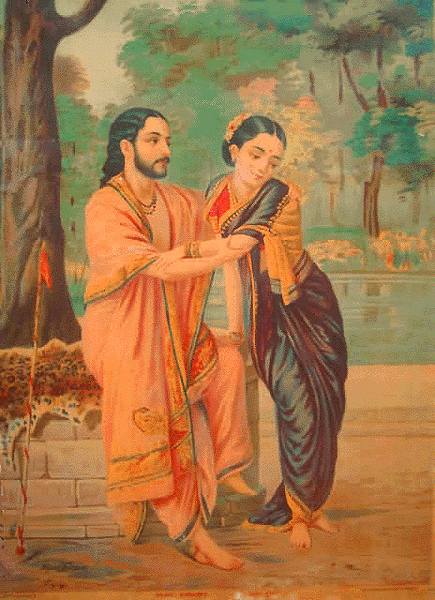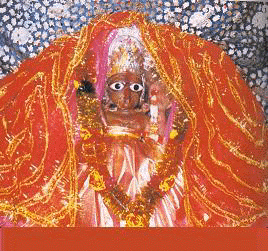The Marriage of Arjuna and Subhadra
BY: SUN STAFF

Arjuna Courts Subhadra
Painting by Raja Ravi Varma
Mar 12, CANADA (SUN) — In the southwestern part of Rajasthan is the town of Jalore, named after its large groves of Jal trees, which were the sacred groves of the sage Jabali. During the Vedic age, one of the nine sons of Manu, his fourth son, established his kingdom here in Jalore, known as Anart. According to Dhundumara, Ayodhya’s Ikshvashu king Kuvlasav defeated the local residents here and took control of the place. It remained under the control of the Yadavas until the time of the Battle of Kurukshetra.
In Chapter 86 of the Krsna Book, Srila Prabhupada explains the story of the kidnapping of Subhadra. After many intriguing pastimes, Arjuna and Subhadra were married in the village of Bhadrajun, near Jalore. To this day, Devi Subhadra is worshipped there in the Dhumda Mata temple.
In Krsna Book, Srila Prabhupada writes:
"…King Pariksit became more inquisitive to hear about Krsna and His pastimes, and thus he inquired from Sukadeva Gosvami how his grandmother Subhadra was kidnapped by his grandfather Arjuna at the instigation of Lord Krsna. King Pariksit was very much eager to learn about his grandfather's kidnapping and marriage of his grandmother.
Thus Sukadeva Gosvami began to narrate the story as follows: "Once upon a time, your grandfather Arjuna, the great hero, was visiting several holy places of pilgrimage, and while he was thus traveling all over he happened to come to Prabhasa-ksetra. In the Prabhasa-ksetra he heard the news that Lord Balarama was negotiating the marriage of Subhadra, the daughter of Arjuna's maternal uncle, Vasudeva. Although her father, Vasudeva, and her brother, Krsna, were not in agreement with Him, Balarama was in favor of marrying Subhadra to Duryodhana. Arjuna, however, desired to gain the hand of Subhadra."
As he thought of Subhadra and her beauty, Arjuna became more and more captivated with the idea of marrying her, and with a plan in mind he dressed himself like a Vaisnava sannyasi, carrying a tridanda in his hand. The Mayavadi sannyasis take one danda, or one rod, whereas the Vaisnava sannyasis take three danda, or three rods. The three rods, or tridanda, indicate that a Vaisnava sannyasi vows to render service to the Supreme Personality of Godhead by his body, mind and words. The system of tridanda-sannyasa has been in existence for a long time, and the Vaisnava sannyasis are called tridandis, or sometimes tridandi-svamis or tridandi-gosvamis.
Sannyasis are generally meant to travel all over the country for preaching work, but during the four months of the rainy season in India, from September through December, they do not travel but take shelter in one place and remain there without moving. This non-movement of the sannyasi is called Caturmasya-vrata. When a sannyasi stays in a place for four months, the local inhabitants of that place take advantage of his presence to become spiritually advanced.
Arjuna, in the dress of a tridandi-sannyasi, remained in the city of Dvaraka four months, devising a plan whereby he could get Subhadra as his wife. The inhabitants of Dvaraka as well as Lord Balarama could not recognize the sannyasi to be Arjuna; therefore all of them offered their respect and obeisances to the sannyasi without knowing the actual situation.
One day Lord Balarama invited this particular sannyasi to lunch at His home. Balaramaji very respectfully offered him all kinds of palatable dishes, and the so-called sannyasi was eating sumptuously. While eating at the home of Balaramaji, Arjuna was simply looking over beautiful Subhadra, who was very enchanting even to the great heroes and kings. Out of love for her, Arjuna's eyes brightened, and he began to see her with glittering eyes. Arjuna decided that somehow or other he would achieve Subhadra as his wife, and his mind became agitated on account of this strong desire.
Arjuna, the grandfather of Maharaja Pariksit, was himself extraordinarily beautiful, and his bodily structure was very much attractive to Subhadra. Subhadra also decided within her mind that she would accept only Arjuna as her husband. As a simple girl, she was smiling with great pleasure, looking at Arjuna. Thus Arjuna also became more and more attracted by her. In this way, Subhadra dedicated herself to Arjuna, and he resolved to marry her by any means. He then became absorbed twenty-four hours a day in the thought of how he could get Subhadra as his wife. He was afflicted with the thought of getting Subhadra, and he had not a moment's peace of mind.
Once upon a time, Subhadra, seated on a chariot, came out of the palace fort to see the gods in the temple. Arjuna took this opportunity, and with the permission of Vasudeva and Devaki, he kidnapped her. After getting on Subhadra's chariot, he prepared himself for a fight. Taking up his bow and holding off with his arrows the soldiers ordered to check him, Arjuna took Subhadra away. While Subhadra was being thus kidnapped by Arjuna, her relatives and family members began to cry, but still he took her, just as a lion takes his share and departs. When it was disclosed to Lord Balarama that the so-called sannyasi was Arjuna, and that he had planned such a device simply to take away Subhadra and that he had actually taken her, He became very angry. Just as the waves of the ocean become agitated on a full-moon day, Lord Balarama became greatly disturbed.
Lord Krsna was in favor of Arjuna; therefore, along with other members of the family, He tried to pacify Balarama by falling at His feet and begging Him to pardon Arjuna. Lord Balarama was then convinced that Subhadra was attached to Arjuna, and He became pleased to know that she wanted Arjuna as her husband. The matter was settled, and in order to please the newly married couple, Lord Balarama arranged to send a dowry, consisting of an abundance of riches, elephants, chariots, horses, servants and maidservants."
 Bhaktivedanta Book Trust. HDG A.C. Bhaktivedanta Swami Srila Prabhupada.
Bhaktivedanta Book Trust. HDG A.C. Bhaktivedanta Swami Srila Prabhupada.
Bhadrajun near Jalore was named in honour of the marriage of Subhadra and Arjuna. Having kidnapped his desired wife in Dvaraka, Arjuna and Subhadra headed for Indraprastha, with Subhadra driving the chariot so it could not be said that she was kidnapped. The pair stopped along the way at Bhadrajun, and there they were married.
The marriage ceremony was officiated by a local village brahmana. In exchange for his services, the brahman was given a conch shell (shankh) by Arjuna, and Subhadra gave him her earring. The brahman's village was thereafter known as Sankhvali, near Bhadrajun, and a small temple was erected there. There, in Dhumda Mata temple, Devi Subhadra is worshipped.

Subhadra Devi at Dhumda Mata
Apart from Draupadi, Subhadra was one of three wives taken by Arjuna. Chitrangada and Ulupi were also married to Arjuna, who went into exile alone after having disturbed Draupadi and Yudhisthira in their private quarters. It was during the last part of his exile, while staying at the Dvaraka residence of his cousins, that he fell in love with Subhadra.
Once married, Subhadra and Arjuna had a son, Abhimanyu. Later, Abhimanyu and his wife Uttara had a son, Parikshit, who became the sole surviving member of the enture Kuru dynasty after Abhimanyu was killed at Kurukshetra. Parikshit then succeeded Yudhistira as the emperor of the Pandava kingdom.
There is a famous dramatic piece which depicts the events surrounding Arjuna and Subhadra's marriage. The Kutiyattam drama is based on Kulasekhara Varman's 10th century text, Subhadra Dhananjaya. Today it stands as one of the most important pieces in the repertory of the Kutiyattam temple theatre of Kerala, being the only surviving form of what once was a pan-Indian tradition of classical Sanskrit theatre. The drama describing the loving affairs of Arjuna and Subhadra have been staged for centuries.

Jalore, Rajasthan
